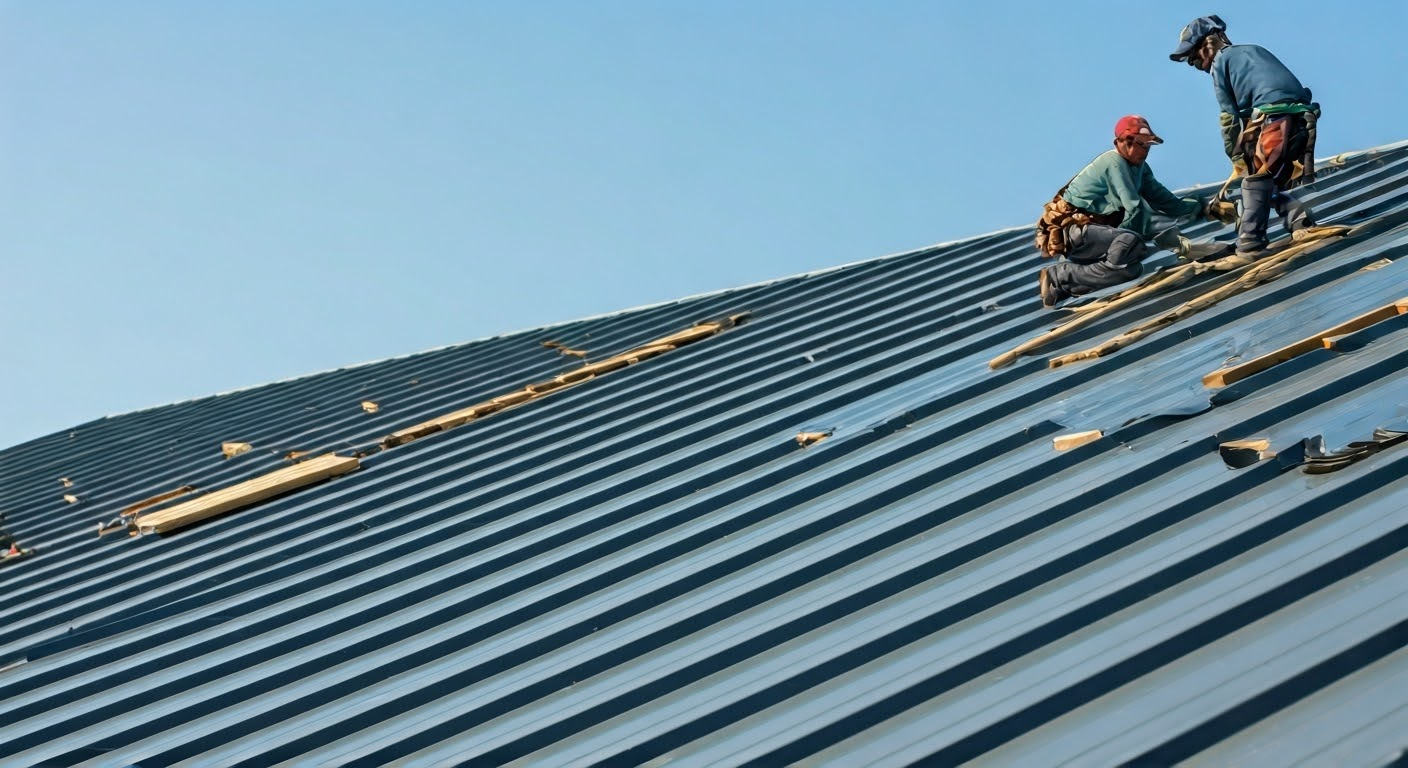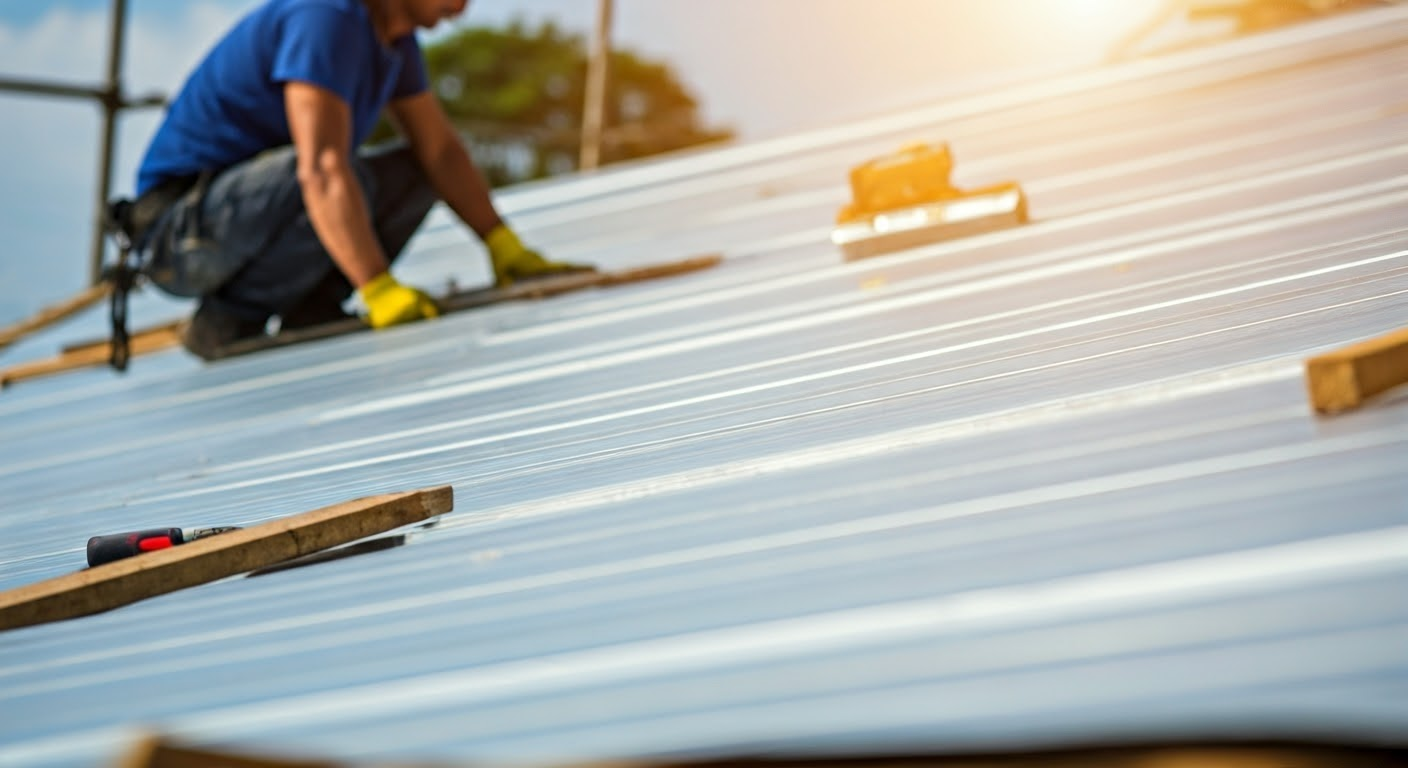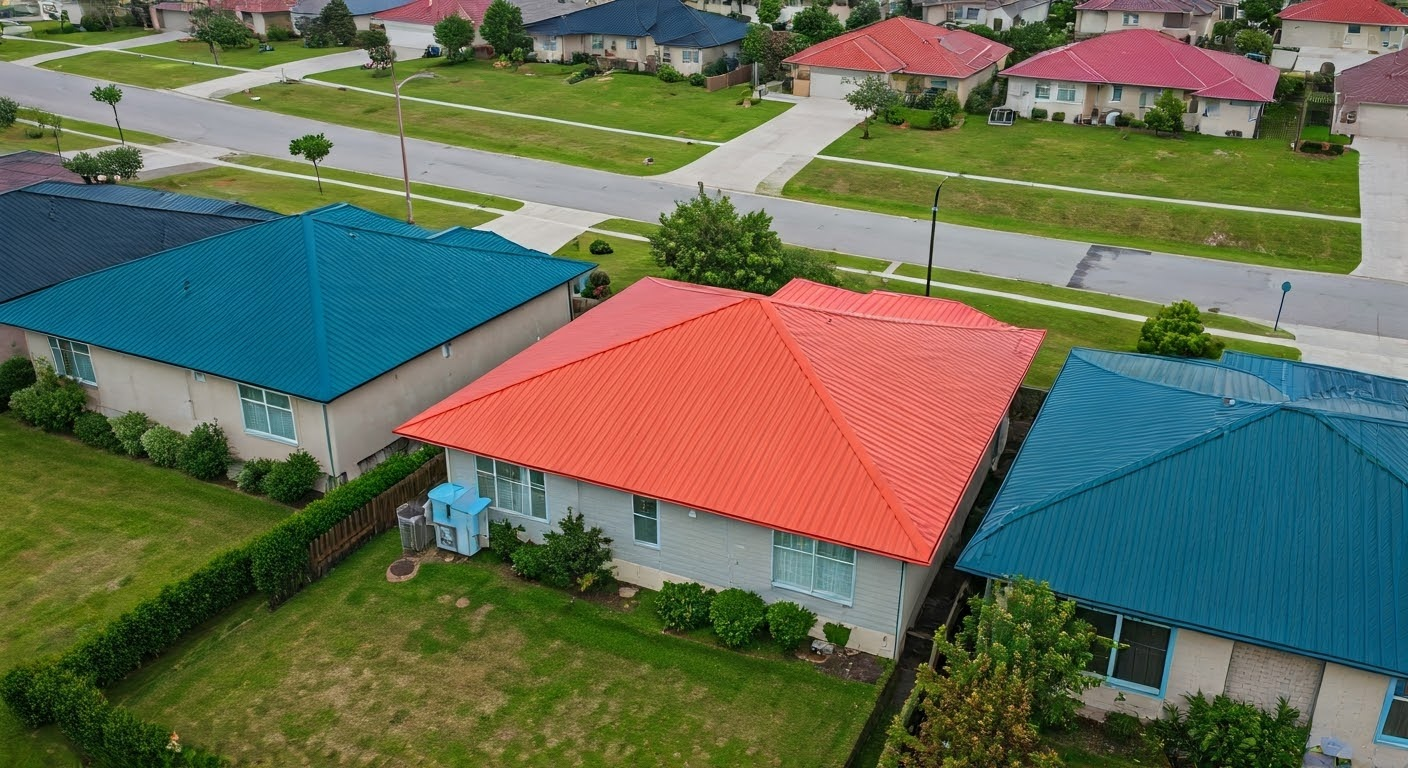
Key Highlights
- While durable, metal roofs have a significantly higher initial cost than traditional options.
- Noise from rain, hail, or falling objects can be amplified on a metal roof.
- Denting is a possibility, especially with softer metals like aluminum, impacting aesthetics.
- Finding experienced installers is crucial, as improper installation can void warranties and lead to problems.
- Thermal expansion and contraction of metal necessitate specific installation techniques for optimal performance.
Introduction
Metal roofing is often praised for its longevity and sleek appearance, but making an informed decision requires understanding its downsides alongside the advantages. While attractive for their durability, metal roofs come with a higher initial cost compared to traditional roofing materials, a factor that often tops the list of concerns for homeowners. Beyond the price tag, potential issues like noise amplification and susceptibility to denting should be carefully considered.
Initial Investment Concerns

One of the most significant drawbacks of metal roofing is the upfront cost. Metal roofing materials, on average, are significantly more expensive than traditional asphalt shingles, often two to three times higher per square foot. This cost difference can be a deal-breaker for homeowners working with a limited budget.
Furthermore, the specialized installation required for metal roofs adds to the overall expense. Experienced installers are a necessity, not a luxury, as improper installation can lead to a cascade of costly problems down the road.
Cost Comparison with Other Roofing Materials
When comparing the cost of roofing materials, metal roofing materials tend to be at the higher end of the spectrum. Asphalt shingles, a popular choice for traditional roofing materials, remain a more budget-friendly option. For example, a standard asphalt shingle roof may cost between $5 and $7 per square foot, while a metal roof can range from $12 to $18 per square foot, depending on the type of metal and complexity of the installation.
This difference in price is driven by several factors. Metal roofing materials, while often containing recycled content, involve a more specialized manufacturing process. Additionally, their durability and longevity command a premium price compared to the shorter lifespan of asphalt shingles.
While the initial investment for a metal roof is undoubtedly higher, it’s crucial to factor in the long-term benefits. Metal roofs typically last much longer than asphalt shingles, requiring less frequent replacement. This longevity can translate into savings over time, potentially offsetting the higher upfront costs.
Long-term ROI Versus Initial Expense
While the upfront costs of metal roofing are undeniably higher, it’s essential to consider the long-term return on investment. An average metal roof can last 40 to 70 years, significantly longer than the average asphalt shingle roof, which typically needs replacement after 15 to 30 years. This extended lifespan means homeowners avoid the cost of multiple roof replacements over the life of their homes.
The durability of metal roofing also contributes to long-term savings. Metal roofs are highly resistant to damage from wind, hail, and fire, reducing the likelihood of costly repairs. Additionally, their energy-efficient properties can lead to lower utility bills by reflecting heat away from the home.
While the initial investment might seem daunting, evaluating the long-run savings potential is key. For homeowners who plan to stay in their homes long-term, the durability, energy efficiency, and longevity of a metal roof can often translate into significant savings and a greater return on investment compared to traditional roofing materials.
Challenges in Installation and Maintenance
Proper installation is critical for any roof, but this is especially true for metal roofs. Their unique characteristics and installation requirements necessitate a specialized skillset that not all roofing contractors possess. Choosing an experienced and qualified installer is non-negotiable.
Maintenance, while generally minimal for metal roofs, requires specific knowledge. Understanding how to conduct inspections, identify potential issues, and carry out repairs is crucial for ensuring the roof’s longevity and maintaining the validity of often-extensive warranties.
Importance of Choosing Skilled Installers
When it comes to metal roof installation, experience matters. Unlike traditional asphalt shingle roofs, metal roofs require a unique set of skills and knowledge. Opting for roofing contractors with years of experience specializing in metal roofing is crucial. Proper installation techniques are paramount to ensuring the roof’s longevity, performance, and warranty validity.
Experienced metal roofing contractors understand the importance of factors like thermal expansion and contraction, which can impact the roof’s long-term performance. They are familiar with the specific details of different types of metal roofing systems and can ensure correct installation based on the chosen material and design.
Don’t hesitate to inquire about a contractor’s experience specifically with metal roofs. Requesting references from previous metal roofing projects and verifying licensing and insurance are essential steps in selecting a qualified professional for the job.
Regular Maintenance Requirements
While metal roofs are renowned for their durability and minimal maintenance needs, regular inspections and upkeep are essential for maximizing their lifespan. Implementing a preventative maintenance schedule helps identify and address potential issues before they escalate into major problems.
Here are some key maintenance tasks for a metal roof system:
- Regular inspections: Conduct visual inspections annually, paying close attention to seams, fasteners, and flashings. Look for signs of damage, corrosion, or loose components.
- Debris removal: Keep the roof clear of leaves, branches, and other debris that can accumulate and trap moisture, promoting corrosion or blocking drainage.
- Gutter cleaning: Clogged gutters can cause water to back up onto the roof, potentially leading to leaks or damage. Ensure gutters are clear and free-flowing.
- Prompt repairs: Address any signs of damage, leaks, or loose components promptly to prevent further deterioration or more costly repairs down the line.
By proactively addressing these maintenance needs, homeowners can protect their investment and ensure their metal roof system provides decades of reliable performance.
Common Performance Issues
Even with proper installation and maintenance, there are performance issues specific to metal roofs that homeowners should be prepared for. Noise, particularly during heavy rain or hailstorms, is a common complaint. The sound of impact on metal is generally louder than on other roofing materials.
While generally durable, metal roofs can dent. Falling branches, large hailstones, or even foot traffic during installation can cause dents. The extent of this issue depends on the specific type of metal used; softer metals, like aluminum, are more susceptible than steel.
Noise During Rain or Hail
One of the most frequently cited drawbacks of metal roofs is the potential for noise, primarily during rainfall. The sound of rain on a metal roof, especially during a heavy rainfall, can be significantly louder compared to traditional asphalt shingles. This amplified noise is due to the hard, non-porous surface of metal, which reflects sound waves rather than absorbing them like other roofing materials.
The noise levels can vary depending on factors like the type of metal used, the roof’s design, and the amount of insulation in the attic. For example, thicker gauge metal tends to be quieter than thinner gauge options. Additionally, using solid sheathing beneath the metal panels can help dampen sound transmission.
Homeowners concerned about noise should consider these factors when choosing a metal roof. Adding extra insulation in the attic can also significantly reduce noise transfer from the roof into the living spaces, making a difference in comfort, especially during heavy downpours.
Denting from Impact
While metal roofs are generally known for their durability, it’s important to acknowledge the risk of damage from impact, particularly denting. Falling tree branches, large hailstones, or even mishandled tools during maintenance can leave dents in a metal roof. The extent of dent resistance varies depending on the type of metal used.
Steel roofing is known for its higher dent resistance compared to aluminum or copper options. Thicker gauge metal panels also provide greater resistance to impact. While minor dents might not impact the roof’s functionality, they can be aesthetically unappealing.
If you live in an area prone to hailstorms or have large trees near your home, choosing a metal roof with higher dent resistance, like steel with a thicker gauge, is advisable. Discussing these considerations with a roofing professional can help determine the most suitable option for your specific location and needs.
Risk of Corrosion Over Time
While metal roofs are lauded for their long-term durability, the risk of corrosion over time should be considered. Corrosion, the gradual deterioration of metal due to exposure to moisture and oxygen, can impact the structural integrity and appearance of metal panels. However, the susceptibility to corrosion varies greatly depending on the type of metal and protective coatings used.
Steel, while incredibly strong, is more prone to rust than other metal roofing options. Aluminum, on the other hand, naturally forms a protective oxide layer that helps resist corrosion. Modern metal roofing systems often incorporate protective coatings, like zinc or aluminum-zinc alloys, to enhance corrosion resistance.
When choosing a metal roof, inquire about the specific metal type, gauge, and protective coatings used to evaluate its long-term durability and resistance to corrosion. Regular maintenance, including inspections for early signs of corrosion and prompt repairs, is essential for mitigating this risk and extending the lifespan of your metal roof.
Aesthetic and Design Limitations
 While often praised for their modern and sleek appearance, metal roofs come with inherent aesthetic limitations. One of the main concerns is the limited range of colors and styles available compared to traditional asphalt shingles, potentially impacting curb appeal, especially in neighborhoods with diverse architecture.
While often praised for their modern and sleek appearance, metal roofs come with inherent aesthetic limitations. One of the main concerns is the limited range of colors and styles available compared to traditional asphalt shingles, potentially impacting curb appeal, especially in neighborhoods with diverse architecture.
Metal roofs might not always complement the architectural style of every home. This is particularly true for older or historically significant homes where the visual appeal often leans towards traditional materials and designs.
Fewer Color and Style Options
One potential aesthetic issue to consider with metal roofs is the limited range of colors and styles compared to traditional roofing materials, particularly asphalt shingles. While manufacturers are expanding their offerings, metal roofing options can still feel somewhat restricted, potentially impacting curb appeal, especially for homeowners seeking a very specific look.
Asphalt shingles come in an almost endless array of colors, textures, and profiles, allowing for highly customized aesthetic choices. Metal roofs, while available in various colors, typically have smoother profiles and fewer design options. This limitation might be a drawback for homeowners in neighborhoods with strict aesthetic guidelines or those who desire a more unique or architecturally intricate roof design.
If curb appeal is a top priority, carefully weigh the available options for different types of metal roofs. Consulting with roofing professionals or designers experienced in metal roofing can help determine the best choices to achieve your desired aesthetic within the constraints of the material.
Compatibility with Building Architecture
Beyond color and style options, the overall compatibility of a metal roof with a home’s existing architecture is crucial to consider. While metal roofs have gained popularity, their visual appeal might not harmonize with every architectural style. Homes with intricate designs or those built in traditional styles, like Victorian or Colonial, might be better suited to the aesthetic of architectural asphalt shingles or other roofing materials that offer a wider range of designs.
The visual appeal of a home significantly relies on the cohesiveness of its architectural elements. Choosing a roofing material that complements, rather than clashes with, the home’s style is essential. Metal roofs, with their modern and sleek aesthetic, are often a natural fit for contemporary homes or those with minimalist designs.
For homeowners seeking to preserve a particular architectural style or enhance the existing visual appeal, carefully evaluating the compatibility of a metal roof with their home’s design is key. Consulting with an architect or designer experienced in roofing and historic preservation can provide valuable insights during the decision-making process.
Conclusion
In conclusion, metal roofs have their advantages but also come with drawbacks that should be considered before making a decision. Factors such as initial investment concerns, challenges in installation and maintenance, common performance issues, and aesthetic limitations should be weighed against the benefits of durability and energy efficiency. It is essential to conduct thorough research and consult with professionals to determine if a metal roof is the best choice for your property. Understanding both the pros and cons will help you make an informed decision that suits your needs and preferences.
At Metal Roof Mobile AL, we ensure our clients receive the best possible outcomes. Our commitment to quality workmanship and customer satisfaction is unwavering, making us the top choice for residential Roofing services in our community.
Frequently Asked Questions
Can Metal Roofs Withstand Severe Weather Conditions?
One of the most significant advantages of metal roof durability is its ability to withstand extreme weather conditions. Metal roofs are designed to withstand strong winds, often exceeding 100 miles per hour, and are highly resistant to damage from hail and heavy rainfall. Their non-combustible nature also makes them a safer option in areas prone to wildfires.
